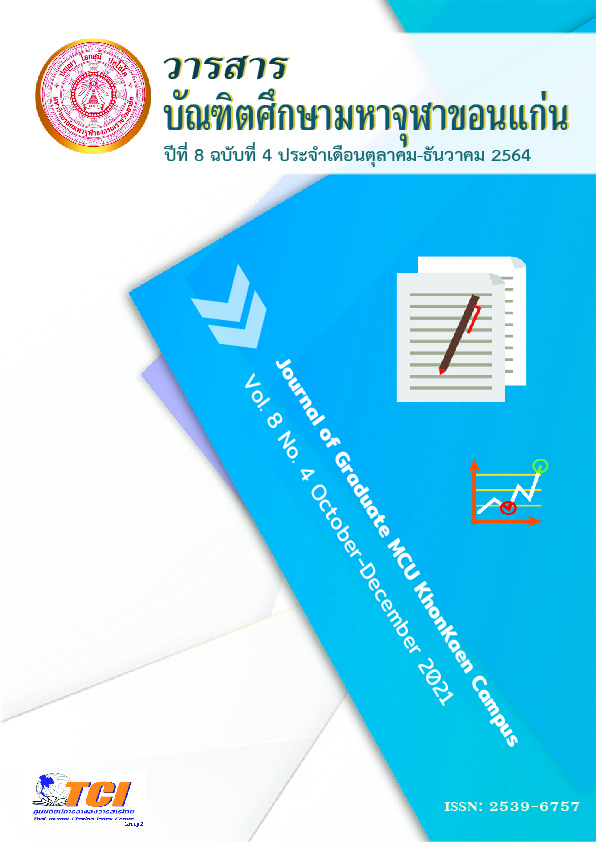ADOLESCENT PROBLEM CONSULTING STRATEGIES IN WAI SAEP SARAEK KHAT NOVEL SERIES
Main Article Content
Abstract
This research is descriptive research, from the novel series “Wai saeb saraek Kad Project 1 and Project 2.” The purposeful to study and gather information on 7 problems. These include family problem "TangMay", media harassment problem "Minnie", aggressive behavior problem "Luk Wai", gender diversity problem "AI Aoon", autistic child problem "BaiPad", game addiction problem "Book" and anxiety stress "V-Neung" Objectives:
1. To study the content strategies of adolescent problems in counseling on adolescent problems in the novel “Wai saeb saraek Kad.” 2. To study the speech acts strategies that appeared in the counseling of adolescents in the novel “Wai saeb saraek Kad.” 3. To study the phrasing strategies of presenting counseling for adolescent problems in the novel “Wai saeb saraek Kad.”
The results of the research showed that: 1) Content strategies in the storyline, there are similar and consistent characters. Namely, the quiet habits. This is due to a lack of warmth, Expectations, including not being accepted by society, adolescents self-harm and others. In the theme, the problem of adolescents is mainly due to a lack of family care. The dialogue and scenes are realistic. How to conversation is depends on the person's relationship and the occasion. 2. The speech acts strategy; It was found that the counselors used direct speech for the suggestion, expression, and instruction to the consultant. 3. phrasing strategies, It was found that counselors used the same level of verbal tactics similar to indirect speech. Sentence tactics were found. Strategies for using idioms specific to adults and found a strategy to use images. All of this is for the consult ants to have an imagination, Mood changes, encouragement, beliefs, and positive attitudes. By all 3 items, discuss the outcome: There is a similar and consistent sequence of steps. Can compile and can be applied to benefit adolescent counselors in the future.
Article Details
References
กุหลาบ มัลลิกะมาส. (2520). วรรณคดีวิจารณ์. กรุงเทพมหานคร: คณะมนุษยศาสตร์และสังคมศาสตร์ โรงพิมพ์มหาวิทยาลัยรามคำแหง.
คณะกรรมการส่งเสริมการพัฒนาเด็กและเยาวชนแห่งชาติ. (2561). แผนพัฒนาเด็กและเยาวชนแห่งชาติ ฉบับที่ 2 พ.ศ. 2560-2564. (พิมพ์ครั้งที่ 2). กรุงเทพมหานคร: สำนักพิมพ์ เจ.เอส. การพิมพ์.
ณัฐิยา ศิรกรวิไล. (2559). วัยแสบสาแหรกขาดโครงการ 1. บริษัท พิมพ์ดี สถาพรบุ๊ค.
ณัฐิยา ศิรกรวิไล. (2562). วัยแสบสาแหรกขาดโครงการ 2. บริษัท พิมพ์ดี สุนทรีย์แห่งรัก.
ทรงธรรม อินทจักร. (2550). แนวคิดพื้นฐานด้านวัจนปฏิบัติศาสตร์. กรุงเทพมหานคร: มหาวิทยาลัยธรรมศาสตร์.
ธัญญา สังขพันธานนท์. (2539). วรรณกรรมวิจารณ์. ปทุมธานี: สำนักพิมพ์นาคร.
นภาลัย สุวรรณธาดา. (2530). สำนวนโวหารในการสื่อสาร. ในมหาวิทยาลัยสุโขทัยธรรมาธิราช, เอกสารการสอนชุดวิชาภาษาเพื่อการสื่อสาร หน่วยที่1-7 (หน้า 238-255). นนทบุรี: มหาวิทยาลัยสุโขทัยธรรมาธิราช.
ปวิวัณณ์ คําเจริญ (2543.). นวนิยายรูปแบบจดหมายของไทย. ใน วิทยานิพนธ์อักษรศาสตรมหาบัณฑิต สาขาวิชาวรรณคดีไทย คณะอักษรศาสตร์. จุฬาลงกรณ์มหาวิทยาลัย.
เยาวภา มูลเจริญ. (2558). องค์ประกอบของนวนิยายที่ได้รับคัดเลือกเข้ารอบสุดท้ายรางวัลวรรณกรรมสร้างสรรค์ยอดเยี่ยมแห่งอาเซียน (ซีไรต์) ประจำปี 2558. วารสารมนุษย์ศาสตร์และสังคมศาสตร์ มหาวิทยาลัยพะเยา, 7(2), 75-87.
วัลลภา วิทยารักษ์. (2557). พลังภาษา พลังความคิด: สัมฤทธิผลในการเขียน. วารสารวรรณวิทัศน์, 14(1), 37-57.
สมเกียรติ รักษ์มณี. (2551). ภาษาวรรณศิลป์. (พิมพ์ครั้งที่ 3). กรุงเทพมหานคร: สำนักพิมพ์ สายน้ำใจ.
สายทิพย์ นุกูลกิจ. (2543). วรรณกรรมไทยปัจจุบัน. (พิมพ์ครั้งที่ 2). กรุงเทพมหานคร: มหาวิทยาลัยศรีนครินทรวิโรฒ.
อัครา บุญทิพย์. (2535). การเขียน. กรุงเทพฯ: ภาควิชาภาษาไทยและภาษาตะวันออกคณะมนุษยศาสตร์ มหาวิทยาลัยศรีนครินทรวิโรฒ.

